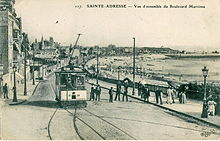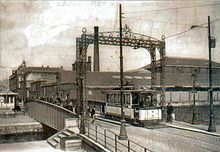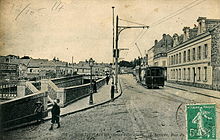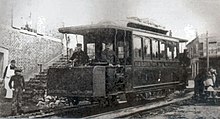Le Havre tram
| Le Havre tram | |
|---|---|
| Test drive on Avenue Foch (June 2015) | |
| Basic information | |
| Country | France |
| city | Le Havre ( Seine-Maritime ) |
| opening | December 12, 2012 |
| operator | CTPO ( Veolia Transdev ) |
| Infrastructure | |
| Route length | 13 km |
| Gauge | 1435 mm ( standard gauge ) |
| Power system | 750 V DC overhead line |
| Stops | 23 |
| business | |
| Lines | 2 |
| Clock in the peak hours | 6 min |
| Cruising speed | 19 km / h |
| vehicles | 22 Alstom Citadis 302 |
| Tram line map | |
The Le Havre tram ( French Tramway du Havre ) is the tram system in the French city of Le Havre . The new network in the largest city in Normandy opened on December 12, 2012. It is owned by the Communauté d'agglomération Havraise and is operated by the transport company CTPO, a subsidiary of Veolia Transdev . The route network comprises two lines with a total length of 13 kilometers. There was already a tram in Le Havre from 1874 to 1951.
The old tram (1874–1951)
Horse tram
Le Havre, which was founded as a port city in the early 16th century, was connected to the railway network in 1847. This led to rapid industrialization , which in turn led to a marked increase in the number of inhabitants. The city sought to solve the increasing traffic problems in the early 1870s. Since the time of the July Monarchy trains running horses buses no longer met the requirements. In 1872, the Belgian businessman Frédéric de la Hault, who worked on behalf of the Banque Française et Italienne , presented a project to build a horse-drawn tram . Construction began shortly after the city authorities approved the project on November 3, 1873. The first line opened on February 1, 1874. It connected the landing stage with the rue de Paris, the town hall and the Octroi de Rouen (customs house).
In the first 14 days of operation, over 80,000 passengers used the new train. This success led to the expansion of the route network. Between October 1, 1875 and May 8, 1879, a second line was opened in several stages. It led from the town hall via Quatre Chemins and Broche à Rotir to the Carreau de Sainte-Adresse . In the meantime, on February 2, 1876 , the Banque Française et Italienne transferred the management of the company to the Compagnie générale française de tramways (CGFT).
Electrification and expansion
The CGFT hardly invested in improving the route network. Because of this, the city put pressure on by considering competing companies for new lines. To protect its monopoly, the CGFT decided on October 28, 1892 to electrify the route network and reduce fares. The work was carried out between February and August 1894, the commissioning of the electric tram traffic took place on September 25, 1894. The Compagnie française de matériel de chemin de fer (CFMCF) in Ivry-sur-Seine built 40 motor vehicles. Of these, 24 had a 25 hp engine, while 16 cars were equipped with two identical engines in order to be able to cope with the steep climbs on the route to Sainte-Adresse.
Le Havre was the first major French city to have a fully electrified tram network. After the electrification of the existing network, the CGFT began implementing an extensive expansion program in 1896. The new routes connected different parts of Le Havre with industrial and port facilities as well as several suburbs. The tram reached its peak in 1913, when it carried 21.6 million passengers annually and had 102 motor vehicles and 43 sidecars. The maximum route length was 57.414 kilometers; this included the routes of two small trams and a funicular that had been taken over by the CGFT.
Consequences of the war and closure
In order to be able to maintain operations during the First World War , the CGFT used Belgian and British drivers, and from 1916 women on so-called “easy” routes. Several wagons transported the wounded from the train station to the city's military hospitals. At the beginning of 1917, a three-kilometer makeshift line was built to facilitate the transport of workers to new factories on the Canal de Tancarville . After the end of the war, the CGFT ran into economic difficulties because the lack of maintenance during the war years meant that the tracks and rolling stock had to be repaired at great expense. In the 1920s, staff had to be cut, the timetable was thinned out and several routes that were considered not worth modernizing were shut down. In 1928 the city decided to introduce bus routes . These were initially limited to secondary lines and did not yet constitute serious competition for the trams, whose cars were modernized. The CGFT introduced one-man operation in 1930; In addition, the Société auxiliaire française de tramways (SAFT) supplied new motor vehicles with more powerful engines (75 hp) and modern brakes, which were used on the sloping stretch between the station and Bléville.
The Second World War hit Le Havre hard. After the conquest of France in June 1940, the Germans converted the city into a fortress as part of the Atlantic Wall and used the tram for their own purposes. The operation, which had been interrupted in the meantime, returned to normal temporarily and in December 1940 40,000 passengers were counted daily. The numerous air raids by the Allies between 1941 and 1944 caused considerable damage. A particularly massive bombardment on September 5 and 6, 1944 reduced the city center to rubble and largely destroyed the CGFT facilities. Of the original 107 motor vehicles and 26 sidecars, only 25 and 10 respectively were still drivable, over a dozen employees had died and several depots had been badly damaged.
Operations could be resumed in October 1944. At the end of 1946 eight lines were used again. But the era of the tram seemed to be over. The first trolleybus operated on August 1, 1947 . Finally, on July 13, 1948, the city decided to completely convert the tram to bus and trolleybus operations. The last tram ran almost three years later, on June 4, 1951.
More tracks
The neighboring town of Montivilliers decided to build an overland tram to provide a better connection to Le Havre. The Compagnie française des voies ferrées économiques (VFE) was awarded the contract. They built a meter-gauge electric tram from the landing stage in Le Havre via the local train station and Harfleur to Montivilliers. The commissioning took place on July 12, 1899. 20 Thomson-Houston motor vehicles with an engine output of 65 hp were used, supplemented by ten open sidecars from 1900. Although the Compagnie havraise de tramways électriques (CHTE) took over operations in February 1901, the financial situation deteriorated noticeably. Finally, the CGFT took over the route on December 14, 1908 and integrated it into the rest of the tram network by changing the gauge to standard gauge .
On November 1, 1895, a steam-powered cable tram opened between Rue Clovis and the Sainte-Marie cemetery. The route was 745 meters long (of which 291 meters in the tunnel) and overcame a difference in altitude of 70 meters. The railway operated by the Compagnie du Tramway Funiculaire de la Côte Sainte-Marie proved to be unreliable. As the derailments increased, operations had to be interrupted on March 15, 1896. The line was then converted into an electric tram and reopened on September 15, 1897. Four motor vehicles from Thomson-Houston with an output of 100 hp were used. At the time, it was the most powerful motor vehicle in Europe on a standard-gauge adhesion railway . In September 1898 the company went bankrupt, as did the subsequent one in November 1901. The company continued until August 1902 under a liquidator. In 1911 he was resumed under the control of the CGFT and with more modern rolling stock. In September 1944, the line was irretrievably destroyed by bombardments.
Reintroduction of the tram
After all three trolleybus routes were discontinued on December 29, 1970, local public transport in Le Havre comprised only bus routes - with the exception of the Le Havre funicular . In 1991, the CGFT, which had meanwhile been communalized, was replaced by the Compagnie des transports de la porte océane (CTPO), whose agency is the Communauté d'agglomération Havraise. CTPO has been a subsidiary of Veolia Transdev since 2006 and bears the brand name LiA .
In 2003 the community association Communauté d'agglomération Havraise created a new urban transport plan (plan de déplacement urbains) ; it first mentioned the reintroduction of the tram. A public hearing was held from November 2006 to February 2007 to get the opinion of the population on a new means of transport on its own route (a track-guided trolleybus and a “ Tramway sur pneumatiques ” were also up for discussion ). On March 13, 2007, the delegates of the municipal association decided in principle for a track-guided mode of transport, on July 10, 2007 they definitely opted for a conventional tram.
After another public hearing from October to December 2009, construction work began in March 2010. It was under the direction of the engineering company Systra . The companies Ingérop, Ateliers Lion, Attica and Ateliers Osty were also involved. As is usual with French tram projects, the opportunity was used to upgrade the streets to be driven through with various design measures. For example, 2,300 trees, 17,000 bushes and 50,000 other plants were replanted. The construction costs amount to 395 million euros. 60% of this is attributable to the association of municipalities, 23% to the Département Seine-Maritime and the Haute-Normandie region and 17% to the transport tax payable by companies ( versement transport ). The opening took place on December 12, 2012.
New tram (since 2012)
Route network
The route network is shaped like a Y It is 13 kilometers long, has 23 stops and is served by two lines. The western terminus of both lines is Porte Océane on the beach. On the shared section along the main axes of Avenue Foch, Boulevard de Strasbourg and Cours de la République, the town hall, the sub-prefecture, the Palace of Justice, the train station and the University of Le Havre are accessible in the city center . The range of hills with the Sainte-Marie cemetery is crossed under in a tunnel around 700 meters long. This runs parallel to the Jenner Tunnel , a road tunnel opened in 1955. The route branches off at Place Jenner (northern tunnel portal). The western branch leads to Mont Gaillard and Grand Hameau (near the airport ), the eastern to Cacriauville Pré-Fleuri. During rush hour there is a tram every three minutes on the main route and every six minutes on the outer branches.
vehicles
The community association organized a public tender for the choice of rolling stock. On July 1, 2010, the French company Alstom was awarded the contract. 22 Alstom Citadis 302 vehicles were delivered for a total of 54.6 million euros. The five-part vehicles are 32 meters long and 100% low-floor . Although the area around the Avenue Foch and the City Hall for World Heritage of UNESCO heard those responsible decided the whole track with overhead lines equip, in contrast to Nice (battery) or Bordeaux (track). The depot is located near the Grand Hameau terminus. The first vehicle was delivered on February 13, 2012.
See also
literature
- Hervé Bertin: Petits Trains et Tramways haut-normands . Cénomane / La Vie du Rail, Le Mans 1994, ISBN 2-905596-48-1 .
- Jacques Chapuis: Les tramways du Havre . In: Chemins de fer régionaux et urbains . No. 105. FACS et UNECTO, 1970, ISSN 1141-7447 .
- José Banaudo: Sur les rails de Normandie . Éditions du Cabri, Menton 2009, ISBN 2-914603-43-6 .
Web links
- Tram project website (French)
- Operator's website CTPO (French)
- Information on the website of the association of municipalities (French)
Individual evidence
- ^ Bertin: Petits Trains et Tramways haut-normands. P. 198.
- ↑ a b c Bertin: Petits Trains et Tramways haut-normands. P. 199.
- ↑ a b Chapuis: Les tramways du Havre. P. 6.
- ^ Chapuis: Les tramways du Havre. P. 44.
- ^ Chapuis: Les tramways du Havre. Pp. 125-128.
- ^ Chapuis: Les tramways du Havre. P. 201.
- ↑ Banaudo: Sur les rails de Normandie. P. 266.
- ^ Bertin: Petits trains et tramways haut-normands. P. 203.
- ^ Chapuis: Les tramways du Havre. P. 64.
- ^ A b c Bertin: Petits trains et tramways haut-normands. P. 204.
- ^ Chapuis: Les tramways du Havre. P. 65.
- ^ Chapuis: Les tramways du Havre. Pp. 138-141.
- ^ Chapuis: Les tramways du Havre. P. 91.
- ^ Chapuis: Les tramways du Havre. P. 94.
- ↑ a b Le Havre - Trolleybus. (No longer available online.) Musée des Transports Urbains, Interurbains et Ruraux (AMTUIR), archived from the original on January 31, 2011 ; Retrieved October 29, 2012 (French). Info: The archive link was inserted automatically and has not yet been checked. Please check the original and archive link according to the instructions and then remove this notice.
- ^ Bertin: Petits trains et tramways haut-normands. P. 205.
- ^ A b Bertin: Petits trains et tramways haut-normands. P. 208.
- ^ Chapuis: Les tramways du Havre. P. 32.
- ^ Chapuis: Les tramways du Havre. Pp. 36-37.
- ^ Chapuis: Les tramways du Havre. Pp. 24-25.
- ^ A b Bertin: Petits trains et tramways haut-normands. P. 207.
- ^ Chapuis: Les tramways du Havre. Pp. 28-29.
- ^ Chapuis: Les tramways du Havre. P. 31.
- ^ Conseil communautaire, séance du 18 December 2007. Communauté d'agglomération Havraise, accessed on October 29, 2012 (French).
- ↑ Conseil communautaire, séance du 10 juillet 2007. Communauté d'agglomération Havraise, accessed on October 29, 2012 (French).
- ↑ Qui fait quoi? (No longer available online.) Tramway de l'agglomération Havraise, archived from the original on December 19, 2012 ; Retrieved October 29, 2012 (French). Info: The archive link was inserted automatically and has not yet been checked. Please check the original and archive link according to the instructions and then remove this notice.
- ↑ Le chantier en bref. In: Océanes, No. 154, March 2012, p. 15.
- ↑ Combien ça coûte? (No longer available online.) Tramway de l'agglomération havraise, archived from the original on June 23, 2012 ; Retrieved October 29, 2012 (French). Info: The archive link was inserted automatically and has not yet been checked. Please check the original and archive link according to the instructions and then remove this notice.
- ^ Bureau communautaire, réunion du 1 juillet 2010. Communauté d'agglomération havraise, accessed on October 29, 2012 (French).









